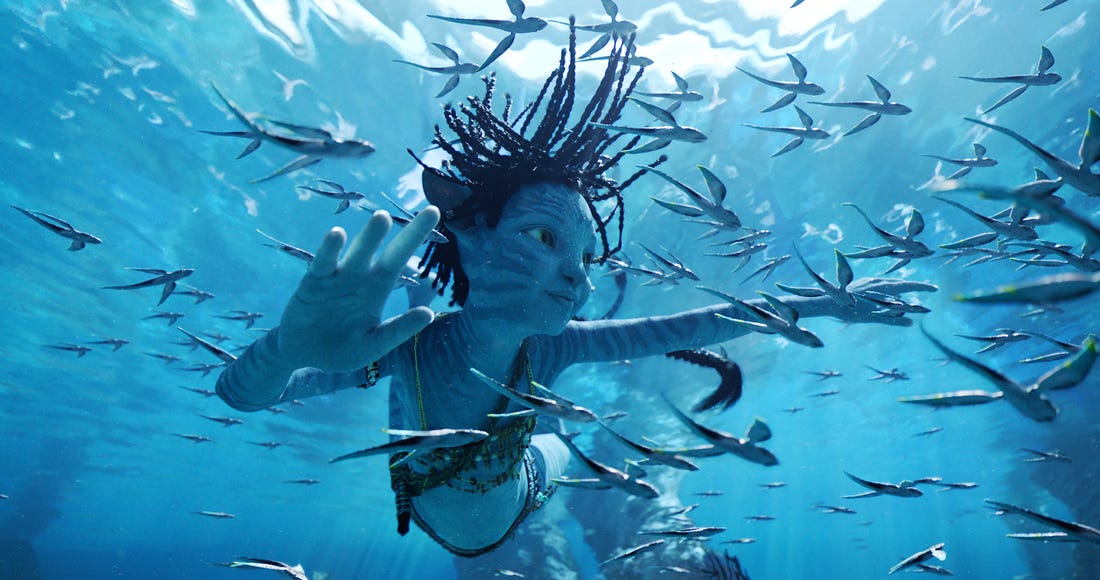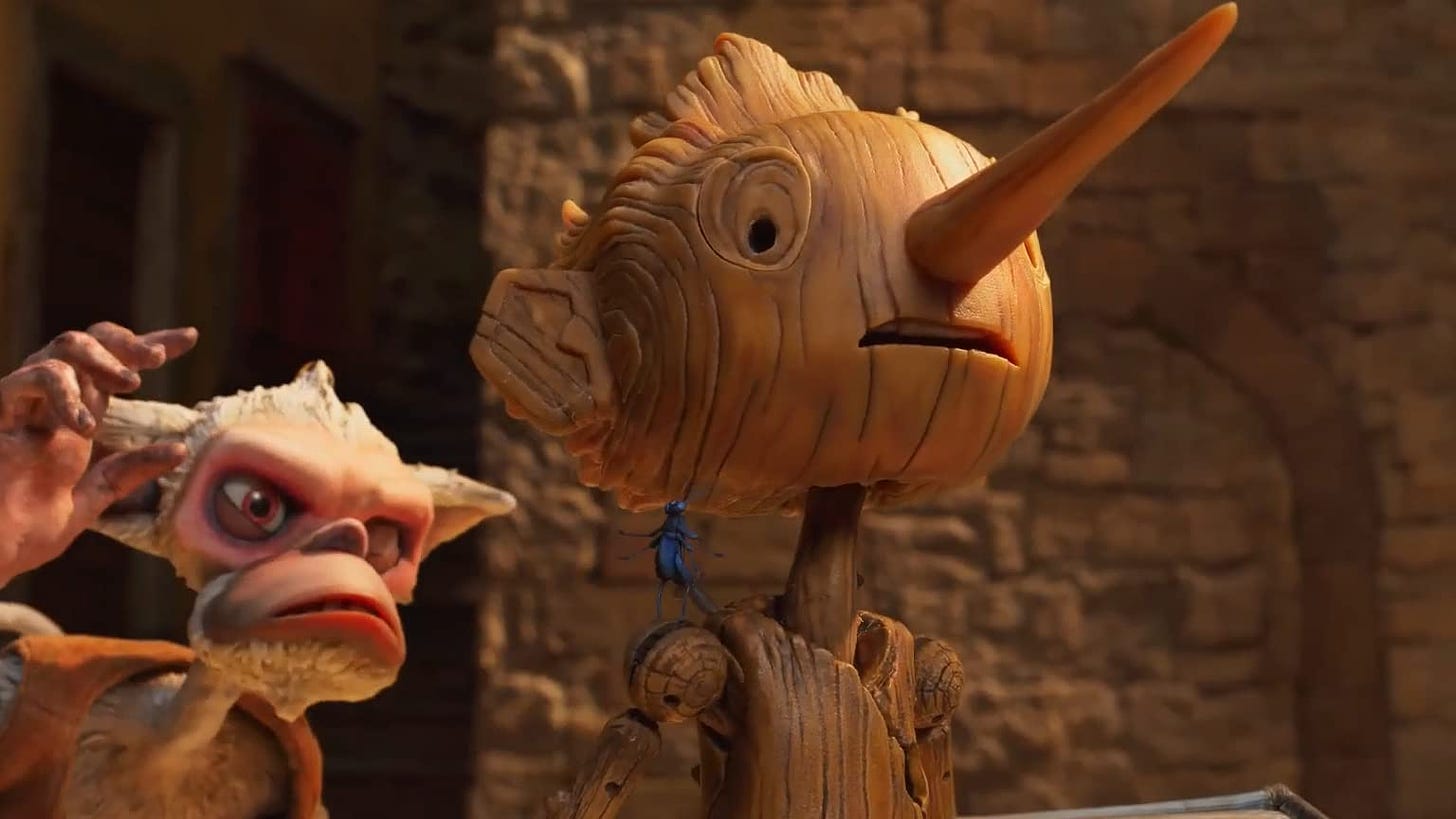In Review: 'Avatar: The Way of Water,' 'Guillermo del Toro's Pinocchio'
In theaters, James Cameron returns to Pandora for an ambitious sequel while on Netflix, Guillermo del Toro refashions Pinocchio as a story about fascist Italy.
Avatar: The Way of Water
Dir. James Cameron
190 min.
One of the most affecting moments in Avatar: The Way of Water, James Cameron’s sequel to his 2009 hit Avatar, sounds ridiculous on paper but here goes anyway. Deep in the film, Lo’Ak (Britain Dalton) — the rebellious second son of Jake Sully (Sam Worthington) and Neytiri (Zoe Saldaña), the heroes of the first film — bonds with Payakan, an outcast Tulkun, one of the sentient whale-like creatures who share a special bond with the Metkayina and other Na’vi clans who live in the villages alongside Pandora’s ocean. Payakan is an outcast, which helps explain his connection to Lo’Ak, who similarly feels like a misfit after leaving the forest for a new life by the sea. Wanting to know why the other Tulkuns shun him, Lo’Ak asks Payakan outright. His answer, delivered in a kind of Pandoran whalesong, is rendered in subtitles that read: “It’s too painful.”
And for some reason, this works. Actually, there are several reasons, which include the film’s remarkable effects and Dalton’s performance (and Payakan’s too, if the word “performance” applies). But chief among them is that Cameron and his team (which includes co-writers Rick Jaffa and Amanda Silver) know what they’re doing. By this point in the film, not only have Lo’Ak and Payakan become flesh-and-blood characters (despite the role pixels play in their creation), the film has expanded the mythology of Pandora so that the cultural distinctions between the forest Na’vi and their beach-dwelling cousins has become meaningful. Cameron has unspooled his tale skillfully enough that, somehow, a sentient space whale’s loneliness feels heartbreakingly heavy.
It didn’t have to be this way. In fact, liking this film so much took me by surprise. I left the original Avatar 13 years ago unimpressed. I thought the 3-D was used well and the effects were impressive but found the characters flat and unappealing and the plot simplistic. I haven’t revisited it since to see if I still feel this way, so liking The Way of Water took me by surprise, and I suspect it will surprise others, too. Avatar, for all its popularity, has picked up a reputation as a blockbuster that’s left no real cultural footprint, at least in part because of the years between sequels, unusual in an era defined by franchises with multi-year plans and countless branches.
Yet the time between sequels shows. Cameron remains a first-rate visual storyteller and the story he’s telling — though still ultimately a fairly straightforward conflict between the colonizing forces of Earth (the “Sky People” in Na’vi speak) and the Na’vi, effectively tall, blue stand-ins for virtually any indigenous population — and the world in which it takes place both feel fully realized. The effects feel even more fully realized. Anyone tempted to write off CGI effects wholesale after the decade-plus, superhero movie-led assault of rushed, unimaginative effects seen in most blockbusters will have to rethink that position after seeing what this film does. It’s not that the tools are bad. It’s that everyone else has been misusing them.
Not that the misuse of technology is entirely alien to this film. I saw Avatar: The Way of Water projected, as Cameron prefers, in a theater equipped to show high-frame rate images. The film is a mix of the usual 24 FPS filmmaking and HFR footage. The mix can be disconcerting as the resolution switches from shot-to-shot and any shot of a human actor still feels much too glassy and uncinematic. There’s a giant close-up of one actor’s head rendered in such realistic detail that it still haunts me. Movies are dreams. They shouldn’t aspire to be that close to real life. But the HFR footage of the Na’vi, particularly the underwater shots, is stunning. (Scott, I should note, feels dramatically different about this to the point of finding the HFR almost unwatchable. It’s a true YMMV element I’m sure we’ll all be discussing in the comments section as others catch up with the film.)
Oh right, the plot: In brief, Jake and Neytiri have to flee when the villain from the first film, Colonel Miles Quaritch (Stephen Lang), returns on a mission of conquest and revenge after being resurrected in a Na’vi body. They’re taken in, grudgingly, by the Metkayina, led by Tonowari (Cliff Curtis) and Ronal (Kate Winslet). The Sullys find themselves struggling to fit in even as danger approaches. Meanwhile, their adopted daughter Kiri (a teenaged character played by Sigourney Weaver) ponders her parentage and Spider (Jack Champion), Quaritch’s human son who’s been raised among the Na’vi, considers where his allegiances lie.
Closer in many respects to a second entry in a series of fantasy novels than a traditional sequel, The Way of Water ties up some of these plot strands. Others it leaves to a sequel. And while it often seemed doubtful that Avatar needed a follow-up in the years since its release, The Way of Water doesn’t inspire that question. Hopefully it won’t take another 13 years. —Keith Phipps
Avatar: The Way of Water opens in theaters everywhere tomorrow.
Guillermo Del Toro’s Pinocchio
Dir. Guillermo Del Toro
117 min.
The fantastical worlds of Guillermo Del Toro have a tendency to interact with the real world at its greatest points of tension, when history provides a dark context for heroism, love, and magic, like a flower sprouting through ugly cracks in the pavement. More than once in Pinocchio, his odd and lovingly hand-crafted take on Carlo Collodi’s 1883 book, the naval mines floating in the Mediterranean Sea in World War II-era Italy are incorporated into the story, along with a stray bomb that acts as the inciting incident for the wooden puppet’s creation. Fans of Del Toro might remember the inert bomb that sits in the courtyard of a small town during the Spanish Civil War in The Devil’s Backbone, a reminder that history has a stake even in worlds where the unimaginable is possible.
With so many versions of Pinocchio trying and failing to live up to Disney’s 1940 classic—the darkest and perhaps the best film in the Disney catalog—Del Toro quite literally carves out his own territory, making the creation of a wooden puppet so tactile that you can see the grain of the wood. (The bent nails sticking out of Pinocchio’s back are a nice touch, too, though more suggestive of Homer Simpson’s spice rack than a carpenter of Geppetto’s quality.) The opening flashes back to an unnamed Italian village during The Great War, when Geppetto (voiced by David Bradley) loses his human son Carlo to a bomb carelessly dropped to lighten a plane’s ballast. Many years later, with Geppetto lost to grief and liquor, a pack of wood sprites animate the pine tree hanging over Carlo’s grave and the potential for magic happens.
Now in the 1930s, a drunken Geppetto carves Pinocchio from the wood and the puppet comes to life, full of energy and mischief. The Blue Fairy (Tilda Swinton) responsible for this miracle entrusts the anthropomorphic cricket Sebastian (Ewan McGregor) to tend to his moral development, a task so formidable that she offers him a single wish if he succeeds. But this wayward child finds trouble quickly, landing at a traveling carnival where the evil ringmaster, Count Volpe (Christoph Waltz), has cozied up to the Fascist forces darkening the country. At one point, his new star attraction, this puppet without strings, is asked to give a private show to Benito Mussolini. It does not go off as planned.
One of the distinguishing features of the Disney version is how far it descends into fairytale darkness, especially when the action leads to Pleasure Island, an amusement park where disobedient boys turn into donkeys. As his answer to that, Del Toro escorts his Pinocchio into a military camp where boys are turned into good little fascist automatons—puppets, of a sort, for Mussolini to use against the Allied forces should they ever be needed in the war effort. Del Toro uses the Pinocchio story to suggest how impressionable children are carved by their environment, particularly when their souls are entrusted to less caring hands than those of Geppetto and Sebastian J. Cricket.
As beautiful as del Toro’s Pinocchio is in design and conceit—the curved ridges on Geppetto’s beard alone are a wonder—the film never quite gains the intended emotional power, despite the sharp contrast drawn between the love of the puppet’s family and the historical darkness encroaching on the country. The songs are wan and forgettable, even with the fine composer Alexandre Desplat providing the music, and only Waltz’s malevolent voice punctures through the din. It’s a marvel to look at and think about, but not much to feel, as if Del Toro was so immersed in the stop-motion minutiae of the film’s design that he lost track of the drama. His Pinocchio never quite becomes a real boy. — Scott Tobias
Guillermo Del Toro’s Pinocchio is currently streaming on Netflix.










I realize the degree to which a film delivers on an emotional level is subjective, but I bristled at the assertion that Del Toro gives the viewer nothing to feel. The central themes of death, grief and humanity got my emotions flowing, with my eyes welling up more than once. And the design of the movie, Del Toro's blend of fantasy and realism, made for some emotionally jarring moments, such as when a "real" gun is produced.
Me pleasantly surprised to see good review of Avatar, and obviously me have to support more blue representation on film... but me still not can get that excited about it.
Me also think stop-motion is entirely wrong medium for Pinocchio. Puppet coming to life lose all of its magic when everyone else is also puppet.